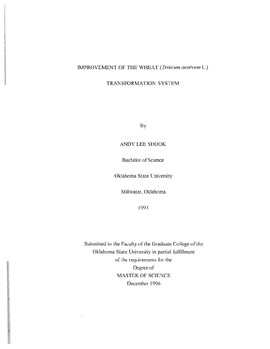| dc.contributor.author | Shook, Andy Lee | |
| dc.date.accessioned | 2014-09-29T21:56:38Z | |
| dc.date.available | 2014-09-29T21:56:38Z | |
| dc.date.issued | 1996-12-01 | |
| dc.identifier.uri | https://hdl.handle.net/11244/12631 | |
| dc.description.abstract | Biolistic(TM) transformation of wheat (Triticum aestivum L.) has been well established. The objective of this research was to determine osmotic treatments maximizing the transformation frequency. Immature wheat embryos were placed on media with 0, 0.2, 0.4,0.6 M mannitol six days after callus initiation. Tissues were bombarded with DNAcoated microprojectiles 5 h after being transferred to treatment media. Tissues were transferred to 1 mg L-1 bialaphos media 16 h after bombardment. All tissues were transformed with the pAHC25 pla'lmid containing bar and uidA genes driven by the ubi-} promoter. Frequencies of recovering embryogenic calli were; 0.6% with no mannitol, 1.2% with 0.2 M mannitol, 5.5% with 0.4 M mannitol, and 8.3% with 0.6 M mannitol. The optimum pre- and post-bombardment treatment for obtaining regenerable callus tissue in the presence of bialaphos was 0.6 M mannitol. | |
| dc.format | application/pdf | |
| dc.language | en_US | |
| dc.publisher | Oklahoma State University | |
| dc.rights | Copyright is held by the author who has granted the Oklahoma State University Library the non-exclusive right to share this material in its institutional repository. Contact Digital Library Services at lib-dls@okstate.edu or 405-744-9161 for the permission policy on the use, reproduction or distribution of this material. | |
| dc.title | Improvement of the Wheat (Triticum aestivum L.) Transformation System | |
| dc.type | text | |
| osu.filename | Thesis-1996-S559i.pdf | |
| osu.accesstype | Open Access | |
| dc.type.genre | Thesis | |
